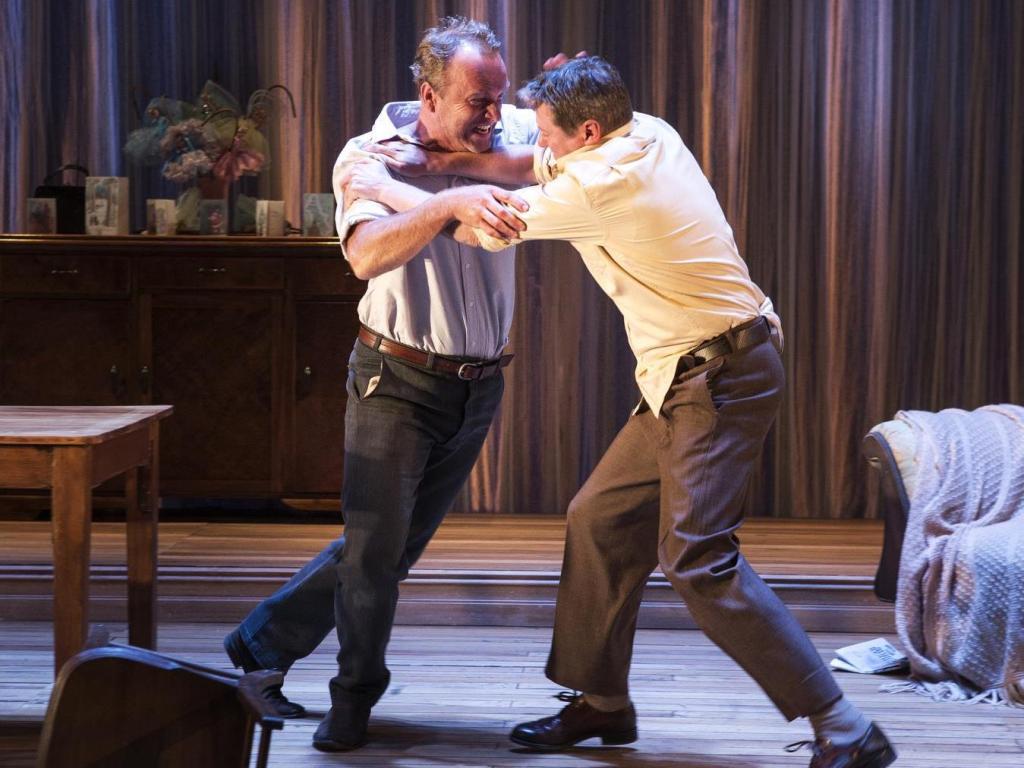Chris Pitman and Rory Walker in STCSA’s Summer of the Seventeenth Doll. Photo by Shane Reid.
Art imitates art in State Theatre Company of South Australia’s production of Ray Lawler’s classic Australian play, Summer of the Seventeenth Doll. Like Lawler’s 1955 play about a good thing ending badly, this production, despite a pleasing first act, soon reveals it’s flaws, and ends in unconvincing melodrama.
Set in 1953, the play tells the story of the 17th summer that Queensland sugarcane-cutters Roo and Barney have spent in Melbourne at the home of Roo’s summertime girlfriend, Olive. Barney’s Olive-equivalent, Nancy, has recently married another man, and to fill the void, Olive has invited Pearl, a fellow barmaid, to stay at her home while the men are down. On arrival, Roo, as he does every year, gives Olive a kewpie doll as a present, but, due to Nancy’s absence, Barney’s drunken lechery, and the fact that Roo’s ‘stony broke’, that’s about the only thing that goes to plan this particular summer.
Lizzy Falkland is excellent as the widow Pearl; she crisply conveys Pearl’s wavering stoicism while capitalising on opportunities for verbal and physical comedy. Elena Carapetis delivers another solid performance as Olive and Jacqy Phillips makes the most of her role as the wise and feisty matriarch Emma. Chris Pitman is never entirely convincing as the legendary sugarcane-cutter Roo, particularly during his emotional final scene. Rory Walker is poorly cast as Barney; he is not convincing as a masculine sugarcane-cutter and even less convincing as a successful womaniser. Also, his inability to clearly enunciate dialogue hinders his performance.
Pip Runciman’s single stylish set consists of an abundance of scrim. The entire back wall of the living room set is made from sheer scrim. The expansive living room is simply decorated with period furniture including an elegant sideboard, a piano, a dining table with chairs, a chaise longue and some stairs leading to another unseen level. Considering that, in Act Three, much is made of the dusty, mouldy, downmarket, worn and dreary nature of Olive’s living room, it is arguable that this stylish, neat, uncluttered set, whilst aesthetically pleasing, is entirely inappropriate.
The living room is flanked by two completely unnecessary downstage ante-rooms that are constructed from walls of scrim. Throughout the play, actors not actively involved in a scene would often sit onstage in either of the two ‘rooms’, barely hidden from the audience behind the diaphanous scrim. This device did not add to the play in any meaningful way. It was distracting, and, when actors are attempting to establish believable characters onstage, it is counterproductive to diminish that belief by having them sit idly on the ‘wrong’ side of the wings, when the characters they portray are meant to be off making food, sleeping or doing whatever it is that the plot demands of them.
Ray Lawler’s play might be an Australian classic but it a middling drama that has dated; this production, while enjoyable in parts, is too flawed to overcome those obstacles.
Rating: 3 out of 5 stars
Summer of the Seventeenth Doll
A State Theatre Company of South Australia production
By Ray Lawler
Director: Geordie Brookman
Set and Costume Desiger: Pip Runciman
Lighting Designer: Nigel Levings
Composer: Quentin Grant
Cast: Elena Carapetis, Lizzy Falkland, Chris Pitman, Rory Walker, Jacqy Philips, Annabel Matheson and Tim Overton
Dunstan Playhouse, Adelaide Festival Centre
24 April – 16 May





